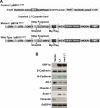LINE-1 couples EMT programming with acquisition of oncogenic phenotypes in human bronchial epithelial cells
- PMID: 29262603
- PMCID: PMC5732769
- DOI: 10.18632/oncotarget.21953
LINE-1 couples EMT programming with acquisition of oncogenic phenotypes in human bronchial epithelial cells
Abstract
Although several lines of evidence have established the central role of epithelial-to-mesenchymal-transition (EMT) in malignant progression of non-small cell lung cancers (NSCLCs), the molecular events connecting EMT to malignancy remain poorly understood. This study presents evidence that Long Interspersed Nuclear Element-1 (LINE-1) retrotransposon couples EMT programming with malignancy in human bronchial epithelial cells (BEAS-2B). This conclusion is supported by studies showing that: 1) activation of EMT programming by TGF-β1 increases LINE-1 mRNAs and protein; 2) the lung carcinogen benzo(a)pyrene coregulates TGF-β1 and LINE-1 mRNAs, with LINE-1 positioned downstream of TGF-β1 signaling; and, 3) forced expression of LINE-1 in BEAS-2B cells recapitulates EMT programming and induces malignant phenotypes and tumorigenesis in vivo. These findings identify a TGFβ1-LINE-1 axis as a critical effector pathway that can be targeted for the development of precision therapies during malignant progression of intractable NSCLCs.
Keywords: EMT programming; LINE-1; oncogenesis.
Conflict of interest statement
CONFLICTS OF INTEREST None.
Figures









References
-
- Siegel PM, Massague J. Cytostatic and apoptotic actions of TGF-beta in homeostasis and cancer. Nat Rev Cancer. 2003;3:807–821. - PubMed
-
- Reck M, Heigener DF, Mok T, Soria JC, Rabe KF. Management of non-small-cell lung cancer: recent developments. Lancet. 2013;382:709–719. - PubMed
-
- Travis WD, Brambilla E, Noguchi M, Nicholson AG, Geisinger KR, Yatabe Y, Beer DG, Powell CA, Riely GJ, Van Schil PE, Garg K, Austin JH, Asamura H, et al. International association for the study of lung cancer/american thoracic society/european respiratory society international multidisciplinary classification of lung adenocarcinoma. J Thorac Oncol. 2011;6:244–285. - PMC - PubMed
LinkOut - more resources
Full Text Sources
Other Literature Sources

